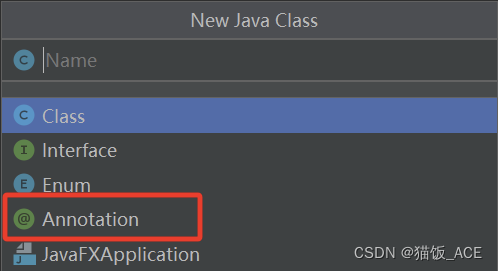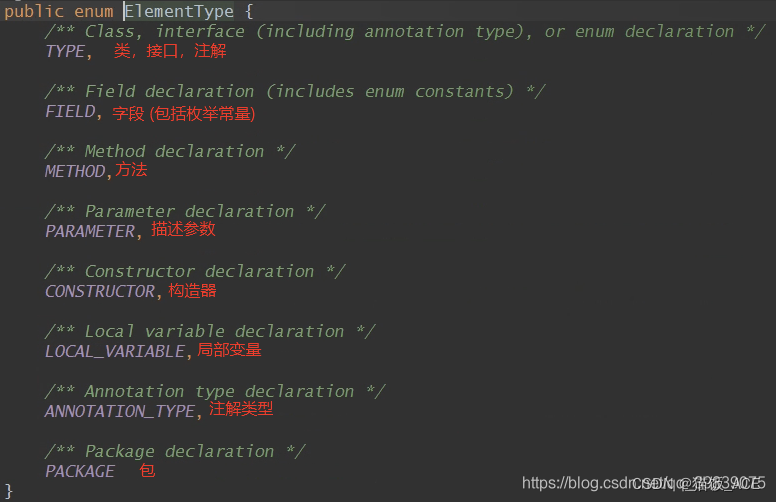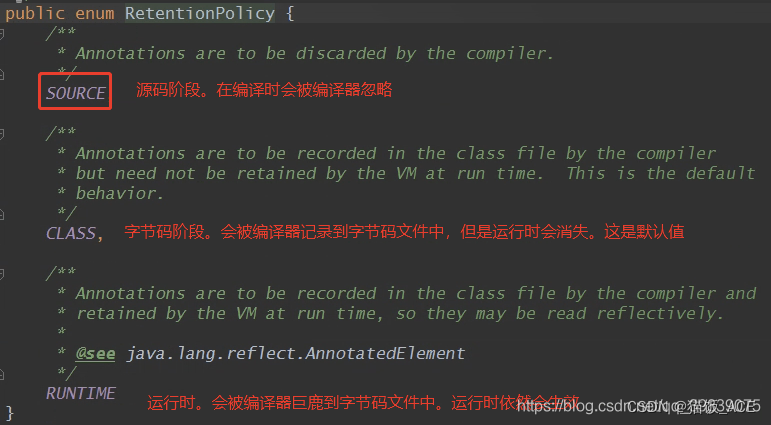自定义注解校验的实现步骤:
1.创建注解类,编写校验注解,即类似@NotEmpty注解
2.编写自定义校验的逻辑实体类,编写具体的校验逻辑。(这个类可以实现ConstraintValidator这个接口,让注解用来校验)
3.开启使用自定义注解进行校验。
第一种实现自定义注解的方式:
一、创建注解类:
1、创建类时,选择Annotation类型

2、编写注解类
编写注解类时,需要用到元注解来规定注解的实现方式等;
package cn.hsa.bis.api.common.utils;import java.lang.annotation.ElementType;
import java.lang.annotation.Retention;
import java.lang.annotation.RetentionPolicy;
import java.lang.annotation.Target;/*** @Description 基础校验注解* @Author chenzz* @create 2020/3/6 19:43*/
//Target注解是指定当前自定义注解可以使用在哪些地方,这里仅仅让他可以使用在字段上;
@Target(ElementType.FIELD)
//指定当前注解保留到运行时;
@Retention(RetentionPolicy.RUNTIME)
public @interface ValiInfo {/*** 最小长度*/int minLen() default 0;/*** 最大长度*/int maxLen() default 2147483647;/*** 非空校验*/boolean notBlank() default false;/*** 字典校验*/String codeType() default "";/*** 非法字符校验* 特殊字符:ascii码表中除字母、数字外的所有字符,顿号(、),间隔号(·)*/String illegalCharRegExp() default ".*[\\x00-\\x2f\\x3a-\\x40\\x5b-\\x60\\x7b-\\x7f\\u3001\\u00b7]+.*";/*** 正则校验*/String regexp() default "";/*** 字段含义*/String mean() default "";/*** 汉字校验*/String regexpChinese() default "";
}
3、元注解 (编写注解类时,必须要明白的)
刚创建出来的注解是不能使用的。因为我们不知道注解应该加在什么地方,在什么时间生效,所以就引出来元注解的概念。元注解就是注解的注解(有点绕口令的感觉)。专门用来注解注解类型。
java的元注解:@Target,@Retention,@Documented,@Inherited
@Target直接指明了该注解生效的位置,该参数没有default值,必填。参数是一个枚举类型

@Retention指明了注解生效的阶段

@Documented
当我们用javaDoc生成API文档时,是否将该注解记录到API文档中。
@Inherited
这个注解是说,我们的注解是否需要被子类继承。是发生在子类和父类之间的一种注解。
注意:当我们的注解作用域是Element.TYPE时,我们定义在类上的注解可以被子类继承。但是如果我们注解的作用域是Element.METHOD时,并且父类的该方法被子类重写,那作用在父类的注解不会被子类继承。所以如果我们在接口的方法中定义的注解,永远不会被实现类继承,因为实现类一定会重写接口中的方法。
二、自定义注解校验逻辑的实现:
这里有两种实现方式,
一种是当注解仅仅作用在字段(属性)上生效时:可以在工具类中编写方法进行逻辑校验;
另一种是当注解作用在方法上生效时,可以使用@Constraint注解,指明了校验类,进行校验;
这里只实现第一种。
第一种:当自定义注解仅仅作用在字段上生效时,在工具类中编写方法进行逻辑校验(在工作中用的比较多)
public class ToolUtils {/*** 对象基础格式校验,针对带有valiInfo注解的属性* @param obj* @param ignoreFields 忽略校验的字段* @return: java.lang.StringBuffer* @author: chenzz* @date: 2020/4/22 23:36*/public static StringBuffer valiObjStringField(Object obj, String[] ignoreFields) {StringBuffer errMsg = new StringBuffer();try {Set<String> ignoreFieldSet = new HashSet<>();ignoreFieldSet.add("class");if (null != ignoreFields) {for (String field : ignoreFields) {if (StringUtils.isNotBlank(field)) {ignoreFieldSet.add(field);}}}PropertyDescriptor[] propertyDescriptors = BeanUtils.getPropertyDescriptors(obj.getClass());for (PropertyDescriptor targetPd : propertyDescriptors) {if (ignoreFieldSet.contains(targetPd.getName())) {continue;}Method readMethod = targetPd.getReadMethod();if (!Modifier.isPublic(readMethod.getDeclaringClass().getModifiers())) {readMethod.setAccessible(true);}Object value = readMethod.invoke(obj);ValiInfo valiInfo = obj.getClass().getDeclaredField(targetPd.getName()).getAnnotation(ValiInfo.class);if (null == valiInfo) {continue;}String mean = valiInfo.mean();if (StringUtils.isBlank(mean)) {mean = targetPd.getName();}// 空置校验boolean isBlank = null == value || StringUtils.isBlank(value.toString());if (valiInfo.notBlank()) {if (isBlank) {errMsg.append(String.format("【%s】不能为空;", mean));continue;}} else {if (isBlank) {continue;}}// 如果是字符串才进行下面的校验if (!(value instanceof String)) {continue;}String strValue = value.toString();// 长度校验 最小长度为0int len = strValue.length();if (len < valiInfo.minLen()) {errMsg.append(String.format("【%s(%s)】长度不能小于%d个字符;", mean, strValue, valiInfo.minLen()));continue;}// 最大长度为2147483647if (len > valiInfo.maxLen()) {errMsg.append(String.format("【%s(%s)】长度不能超过%d个字符;", mean, strValue, valiInfo.maxLen()));Method writeMethod = targetPd.getWriteMethod();if (!Modifier.isPublic(writeMethod.getDeclaringClass().getModifiers())) {writeMethod.setAccessible(true);}writeMethod.invoke(obj, strValue.substring(0, valiInfo.maxLen() - 1));continue;}if (strValue.matches(valiInfo.illegalCharRegExp())) {errMsg.append(String.format("【%s(%s)】中不能包含特殊字符;", mean, strValue));continue;}if (StringUtils.isNotBlank(valiInfo.regexp()) && !strValue.matches(valiInfo.regexp())) {errMsg.append(String.format("【%s(%s)】格式校验不通过;", mean, strValue));continue;}// 校验是否存在汉字if (StringUtils.isNotBlank(valiInfo.regexpChinese())) {char c[] = strValue.toCharArray();Pattern pattern = Pattern.compile(valiInfo.regexpChinese());boolean flag = false;for (int i = 0; i < c.length; i++) {Matcher matcher = pattern.matcher(String.valueOf(c[i]));if (matcher.matches()) {flag = true;}}if (flag) {errMsg.append(String.format("【%s(%s)】入参存在汉字;", mean, strValue));continue;}}// 码值校验if (StringUtils.isNotBlank(valiInfo.codeType())) {if (DictUtil.isNotDict(valiInfo.codeType().toUpperCase(), strValue)) {errMsg.append(String.format("【%s(%s)】不在代码表中;", mean, strValue));}}}return errMsg;} catch (IllegalAccessException e) {throw new BisException(BusinessConst.CALL_FAIL_TYPE_JC, "对象数据格式校验失败!");} catch (InvocationTargetException e) {throw new BisException(BusinessConst.CALL_FAIL_TYPE_JC, "对象数据格式校验失败!");} catch (NoSuchFieldException e) {throw new BisException(BusinessConst.CALL_FAIL_TYPE_JC, "对象数据格式校验失败!");}}
}
三、使用自定义注解:
自定义校验注解在代码中的应用
1、在dto中使用:
@Data
public class PsnInsureInfoQueryDTO implements Serializable {private static final long serialVersionUID = -3173331123860803536L;/*** 缴费开始年月*/@ValiInfo(mean = "缴费开始", minLen = 6, maxLen = 6, regexp = RegexpConst.REGEXP_YM)private String begnYm;/*** 单位编号*/@ValiInfo(mean = "单位编号", minLen = 1, maxLen = 40, illegalCharRegExp = RegexpConst.ILLEGAL_CHAR_REGEXP_EMPNO, regexpChinese = RegexpConst.REGEXP_CHINESE)private String empNo;/*** 险种类型*/@ValiInfo(mean = "险种类型", minLen = 1, maxLen = 3, codeType = "INSUTYPE", regexpChinese = RegexpConst.REGEXP_CHINESE)private String insutype;/*** 统筹区编码*/@ValiInfo(mean = "统筹区编码", minLen = 6, maxLen = 6, codeType = "ADMDVS_PLC", regexpChinese = RegexpConst.REGEXP_CHINESE)private String poolarea;/*** 参保状态*/@ValiInfo(mean = "参保状态", minLen = 1, maxLen = 3, codeType = "PSN_INSU_STAS", regexpChinese = RegexpConst.REGEXP_CHINESE)private String psnInsuStas;/*** 人员编号*/@ValiInfo(mean = "人员编号", minLen = 1, maxLen = 36, notBlank = true, regexpChinese = RegexpConst.REGEXP_CHINESE, illegalCharRegExp = RegexpConst.ILLEGAL_CHAR_REGEXP_PSNNO)private String psnNo;
}
2、在代码中,通过调用valiObjStringField方法来进行校验:
//control层的方法
public ResultVO insertHmcYcx(@RequestBody HmcinfoDTO hmcinfoDTO){//.......其它逻辑//调用方法,进行自定义注解的校验String errorMsg = ToolUtils.valiObjStringField(hmcinfoDTO).toString();if (StringUtils.isNotBlank(errorMsg)) {log.info(errorMsg);return new ResultVO(errorMsg);}//.......其它逻辑ResultVO vo = hmcBPO.insertHmc(hmcinfoDTO);return vo;
}







 】.md updata:23/11/05)


,查看文件(ls,echo,cat)的原理和过程)







![【汇编】[BX]和loop指令(学习笔记)](http://pic.xiahunao.cn/【汇编】[BX]和loop指令(学习笔记))
